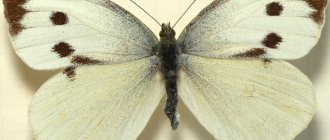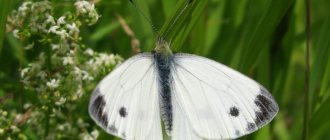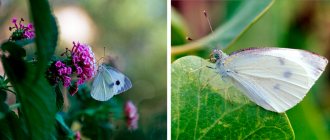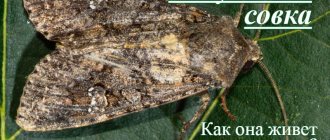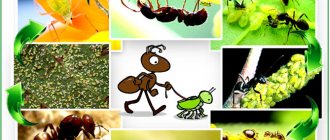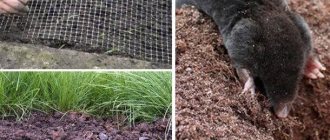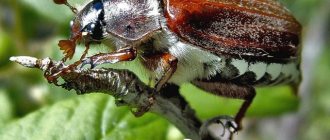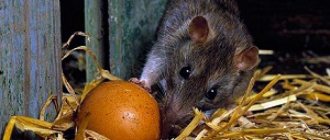The cabbage butterfly is a diurnal representative of the order Lepidoptera of the class of insects. Its other name, white butterfly, symbolizes its color: white wings with small black dots in the center. Whitefish can be seen already in the spring in April or May, fluttering over the first green plants.
Interesting!
Some lovers of lepidopteran insects breed butterflies in their home aquariums. How long cabbage butterflies live in an artificial environment depends on care. They eat the same plants at home as in nature.
But the cabbage butterfly did not gain fame due to its early appearance. It is a dangerous pest of gardens and vegetable plantations. Its larvae are capable of damaging most vegetable crops over the course of a season, although this is not the only thing the caterpillars feed on. Cabbage beds are especially affected by caterpillar infestations. This explains why the insect was named so.
What cabbage whites look like (photo)
Name: Cabbage or cabbage white Lat.:
Pieris brassicaeClass: Insects - Insecta Order: Lepidoptera - Lepidoptera
| Habitats: | a common species, except in Siberia and the desert |
| Peculiarities: | actively migrates, 2-3 generations per season |
| Benefit or harm: | active agricultural pest |
Habitat
The cabbage butterfly lives throughout Eastern Europe, North Africa, East Asia and some regions of South America. It can be found on forest edges and clearings, in gardens and orchards where cruciferous vegetables grow - shepherd's purse, rapeseed, rapeseed, radish and various types of cabbage.
In search of food, butterflies make long flights over long distances. The ability to migrate, natural strength and adaptability to difficult conditions are characteristic of all representatives of the whitefish family. Some individuals of these insects living in the forests of Asia are distinguished by great endurance. The most beautiful and largest individuals of these tropical insects are born during the rainy season.
Description of the insect
The cabbage white is a small butterfly. The width of its open wings is 5.5-6 cm. The main color of the wings is powdery white. In their upper part there is a black border in the shape of a crescent.
Females also have two black spots on their upper wings. In males, these spots can only be seen on the underside of the wings.
Development cycle
Cabbage whites.
Before becoming an adult, an insect goes through several stages.
Egg
The eggs have a ribbed surface and a bottle-shaped shape. They are painted in a bright yellow, lemon color. The length of the egg is 1.25 mm. One female is capable of laying about 200-300 eggs. The period of development in the egg stage ranges from 3 to 16 days.
Caterpillar
In the caterpillar stage, the insect reaches a length of up to 5 cm. The color of the caterpillar is yellow-green. The body is covered with multiple hairs, bristles and warts. The caterpillar's head is clearly defined and dark in color. The larvae also have glands on their bodies that secrete a toxic substance. The insect remains in the caterpillar stage for 13 to 38 days.
Doll
The pupae have an angular shape and are colored yellow-green. There are black dots on the sides and back. The development of the pupa can take from 9 to 30 days. Pupae can overwinter in the ground on mats of mulberries.
Cabbage: appearance and features of the species
The cabbage butterfly or cabbage white (Pieris brassicae) is a butterfly belonging to the white butterfly family (Pieridae).
Adult insects are quite large. Their wingspan reaches 55-60 mm.
Cabbage has a white color, complemented by dark spots at the base. A distinctive external feature of the cabbage white is the presence of a black crescent-shaped spot at the top of the fore wings. The lower wings are yellow with black scales.
The cabbage plant has sexual dimorphism: females are larger than males, in addition, they have different genital organs in structure.
Life cycle of cabbage
The butterfly season begins in the spring. The cabbage white is diurnal; the butterfly is especially active on sunny and hot days; it does not tolerate windy weather well.
The optimal temperature for cabbage is 20-25°C.
Butterflies breed in July-August. After fertilization, females lay eggs on the underside of the leaf in groups of 20-200 pieces. The fertility of the cabbage plant reaches 300 eggs.
Cabbage eggs are pale yellow and skittle-shaped. Their length is about 1.2 mm. After 1-2 weeks, caterpillars emerge from the eggs.
What do cabbage white caterpillars look like?
Cabbage white larvae are gray-green in color with dark brown spots and dots, as well as yellow stripes. The length of the caterpillar is about 3.5 cm. At first, the larvae are motionless and stick together. They feed on the pulp of the undersides of leaves. After a while, the caterpillars crawl around the plant and eat its leaves. If young caterpillars prefer the underside of leaves, then adults prefer the upper side.
There are poisonous glands on the body of the cabbage caterpillar, so birds eating them can die. If the poison gets on human skin, it can cause irritation.
Cabbage caterpillars molt four times. The larval stage can last from two to four weeks, depending on weather conditions. Afterwards, the caterpillar is attached with a belt of silk thread to substrates (stones, trees, stumps, fences) and turns into a pupa.
The pupae are greenish-yellow in color and angular in shape. They have black spots on their sides and back. Pupae are usually located on trees, fences, and walls of buildings; they are much less common on cabbage leaves. The pupal stage lasts on average 10-15 days. Under unfavorable weather conditions, caterpillars of summer generations can produce diapausing pupae; they complete their development after wintering.
Juveniles have a black head, while adults have light spots on it.
The development of the second generation occurs if the first was not destroyed. In the southern regions, up to 3-5 generations of cabbage can develop in one season.
In the southern regions, the first generation appears in April - early May, and in the northern regions - in late May - early June. The second generation develops in late July - early August.
Methods to combat cabbage whites
Getting rid of harmful insects is quite difficult.
The most effective methods of controlling cabbage whites can be divided into mechanical, agrotechnical, biological, chemical and folk.
Mechanical method
This method involves removing caterpillars from plants by hand. It is simple to implement, but quite labor-intensive, so it is suitable only for small plots and private gardens. Most of the larvae will have to be lifted from the ground, since, sensing danger, they curl up and fall from the plants.
Cabbage caterpillar.
Agrotechnical method
In order not to attract insects to the site, it is very important to regularly get rid of cruciferous weeds and plant plants that can repel the pest. These include:
- tomato;
- eggplant;
- carrot;
- parsley;
- Melissa;
- valerian.
Removing plant debris and deep digging in the autumn will also help get rid of overwintering pupae and significantly reduce the butterfly population in the spring.
Biological method
The principle of the biological control method is to settle its natural enemies next to the cabbage plant.
| Smallbellied | A small insect that lays eggs in the body of a caterpillar. The parasites that hatch from these eggs eat their host from the inside. |
| Trichogramma | The parasite also harms the eggs and larvae of Cabbage White. |
| Wax moth bacteria | They infect the larva with the Flasheria disease, which leads to the death of the pest. A distinctive feature of an infected caterpillar from a healthy one is its bright lemon color. |
| Ethnomophages | These are beneficial insects that benefit humans by eating pests. Cabbage white is a favorite delicacy of ticks and predatory ground beetles. |
Chemicals
The use of specialized drugs is the most effective method of control. To destroy Cabbage White, the most popular means are:
- Kinmiks;
- Fitoverm;
- Aktellik;
- Lepidocide;
- Bitoxibacillin;
- Entobacterin;
- Gomelin;
- Dipel.
Folk remedies
Humanity has been fighting cabbage whites for many years, and some folk methods of control are quite effective. Among them it is worth highlighting:
- solution with valerian tincture. For preparation, use 500 ml of valerian tincture per 3 liters of water. The prepared mixture must be thoroughly sprayed on all affected plants;
- dry mustard and wormwood. During the flowering period of wormwood, it is necessary to collect and dry about 1000 g of its inflorescences. After the wormwood has dried, you need to add 100 g of dry mustard and 10 liters of boiling water. The product should be infused for 2-3 days. The finished tincture is diluted with cold water in a 1:1 ratio and used for processing. Spraying must be carried out at least once a week;
- field chamomile flowers and laundry soap . Dried wild chamomile flowers are sold in pharmacies. To prepare the tincture you will need 1 kg of flowers and 10 liters of water. They are infused for 12-24 hours, then filtered and 100 g of laundry soap are added. Another 10 liters of water are added to the finished tincture and used to spray the affected plants.
Nutrition
The butterfly's proboscis is intended only for obtaining nectar. The adult is completely harmless, but its offspring cause enormous harm to agriculture. Farmers protect their land and crops in many ways. Some treat the fields with specialized preparations, but this is an ineffective procedure; competent farmers try to clear their fields of grass and debris as much as possible in the fall.
Butterfly caterpillars are extremely voracious and, if left unchecked, can destroy the entire cabbage crop. This shows their similarity with many other species. Its relatives, which do not harm plants, produce caterpillars that eat the leaves of garden trees.
Prevention measures
Prevention of the appearance of Cabbage White is the timely destruction of pupae and oviposition. To prevent the spread of the pest, you must do the following:
- periodically inspect the underside of the leaves of cruciferous plants and destroy the eggs found;
- inspect dry branches, tree trunks, barn walls and other places where pupae may overwinter;
- Regularly carry out spring whitewashing of tree trunks and main branches.
Interesting Facts
A doll with a cabbage butterfly is the most vulnerable stage in life. She develops in her silk cocoon and has no protective devices. Therefore, it is important that the cocoon is in a safe place.
After a few days, the shell bursts, and a fully formed insect with soft folded wings is born.
- She straightens them and dries them in the sun for several hours.
- After the wings of the cabbage plant have spread and become stronger, the young insect begins to worry about producing offspring.
- The butterfly lives for about twenty days.
Lifespan
The cabbage butterfly lives under favorable conditions for up to 75 days. During this time, it goes through 3 transformations from egg to adult - imago. In butterfly form, the cabbage butterfly lives only about 20 days, feeding on nectar and giving life to a new generation, after which it dies a natural death.
Expert opinion
Victoria Neima
The flight time of the first generation occurs in mid-April and lasts until early June. Butterflies that can be found from mid-July to mid-August are the second generation. And, if the climate allows, the third generation flies from September to October. In the northern latitudes, with cold, short summers and long winters, only two generations of butterflies have time to change, in the southern regions - three and even five.
Subscribe
Egg stage
The frequency of butterfly reproduction depends on temperature conditions. The warmer it is, the more often reproduction occurs, generally two to three times. In light of this, egg laying can occur from April to September.
After mating, the female lays about 200 or more eggs. The first laying is made on wild plants. But already 2 and 3 clutches can be produced on cultivated plants in the gardens of summer residents.
Cabbage life style
The white butterfly is a very active insect and migrates a lot. Cabbage grass is most active from April to mid-October. If the insect’s region of residence is warm enough, it can produce up to three offspring per season.
The butterfly does not fly at night; it is a completely diurnal resident. Peak activity occurs on warmer days when there is no rain. The insect does not like windy weather.
It is believed that white grass greatly harms gardeners. In fact, adults do more good than harm by pollinating plants.
Structure
The cabbage butterfly has a hairy body, very similar to that of the cockchafer. Consists of three departments:
- abdomen;
- head;
- chest with fused segments.
The butterfly has three pairs of legs, at the end of each of which there are very sharp claws that allow it to stay on trees and plants.
Like other butterflies, the cabbage butterfly has only a developed pair of lower chitinous jaws, which can chew even a cabbage leaf.
